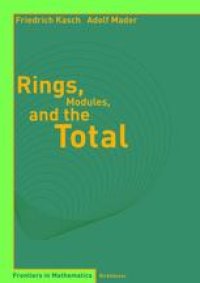
Ebook: Rings, Modules, and the Total
- Tags: Algebra, Associative Rings and Algebras, Group Theory and Generalizations
- Series: Frontiers in Mathematics
- Year: 2004
- Publisher: Birkhäuser Basel
- Edition: 1
- Language: English
- pdf
In a nutshell, the book deals with direct decompositions of modules and associated concepts. The central notion of "partially invertible homomorphisms”, namely those that are factors of a non-zero idempotent, is introduced in a very accessible fashion. Units and regular elements are partially invertible. The "total” consists of all elements that are not partially invertible. The total contains the radical and the singular and cosingular submodules, but while the total is closed under right and left multiplication, it may not be closed under addition. Cases are discussed where the total is additively closed. The total is particularly suited to deal with the endomorphism ring of the direct sum of modules that all have local endomorphism rings and is applied in this case. Further applications are given for torsion-free Abelian groups.
In a nutshell, the book deals with direct decompositions of modules and associated concepts. The central notion of "partially invertible homomorphisms”, namely those that are factors of a non-zero idempotent, is introduced in a very accessible fashion. Units and regular elements are partially invertible. The "total” consists of all elements that are not partially invertible. The total contains the radical and the singular and cosingular submodules, but while the total is closed under right and left multiplication, it may not be closed under addition. Cases are discussed where the total is additively closed. The total is particularly suited to deal with the endomorphism ring of the direct sum of modules that all have local endomorphism rings and is applied in this case. Further applications are given for torsion-free Abelian groups.
In a nutshell, the book deals with direct decompositions of modules and associated concepts. The central notion of "partially invertible homomorphisms”, namely those that are factors of a non-zero idempotent, is introduced in a very accessible fashion. Units and regular elements are partially invertible. The "total” consists of all elements that are not partially invertible. The total contains the radical and the singular and cosingular submodules, but while the total is closed under right and left multiplication, it may not be closed under addition. Cases are discussed where the total is additively closed. The total is particularly suited to deal with the endomorphism ring of the direct sum of modules that all have local endomorphism rings and is applied in this case. Further applications are given for torsion-free Abelian groups.
Content:
General Background....Pages 1-7
Fundamental notions and properties....Pages 9-38
Good conditions for the total....Pages 39-68
The total of modules with LE–decompositions....Pages 69-100
The total in torsion–free Abelian groups....Pages 101-129